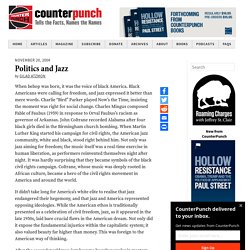

Top 10 Influential Jazz Musicians. Harlem Renaissance Documentary. A Brief History of The Minstrel Show. THE SECOND LINE (Historical Documentary of New Orleans Music & Culture) Martin Luther King Jr. Explains the Importance of Jazz: Hear the Speech He Gave at the First Berlin Jazz Festival (1964) Martin Luther King Jr.’s dream of full inclusion for Black Americans still seems painfully unreal fifty years after his death.

By most significant measures, the U.S. has regressed. De facto housing and school segregation are entrenched (and worsening since the 60s and 70s in many cities); voting rights erode one court ruling at a time; the racial wealth gap has widened significantly; and open displays of racist hate and violence grow more worrisome by the day. Yet the movement was not only about winning political victories, though these were surely the concrete basis for its vision of liberation. It was also very much a cultural struggle. Black artists felt forced by circumstances to choose whether they would keep entertaining all-white audiences and pretending all was well.
Many of those musicians could not stay silent after the murder of Emmett Till, the 16th Street Baptist Church bombing in Birmingham, and a string of other highly publicized and horrific attacks. Via JSTOR Daily. NPR jazz and social protest. Politics and Jazz - CounterPunch.org. When bebop was born, it was the voice of black America.

Black Americans were calling for freedom, and jazz expressed it better than mere words. Charlie “Bird” Parker played Now’s the Time, insisting the moment was right for social change. Charles Mingus composed Fable of Faubus (1959) in response to Orval Faubus’s racism as governor of Arkansas. John Coltrane recorded Alabama after four black girls died in the Birmingham church bombing. When Martin Luther King started his campaign for civil rights, the American jazz community, white and black, stood right behind him. It didn’t take long for America’s white elite to realise that jazz endangered their hegemony, and that jazz and America represented opposing ideologies. After the second world war, jazz became hugely popular in western Europe, and jazz giants such as Bird, Dizzy Gillespie, Miles Davis and Dexter Gordon were treated as major cultural figures.
For the white bourgeoisie, jazz became a problem that had to be addressed. Billie Holiday - Strange Fruit (1939) The Origins of Lynching Culture in the United States. How a Lunch Counter Sit-In Became an Iconic Civil Rights Moment — SFA. We Insist! Max Roach's Freedom Now Suite. Fueling the Civil Rights Movement: Remembering the Music of Max Roach. Little Rock Nine: the day young students shattered racial segregation. Minnijean Brown Trickey didn’t intend to make a political statement when she set off with two friends for her first day in high school.

She was, after all, only 15. “I mean, part of growing up in a segregated society is that it’s a little sort of enclave and you know everybody,” says Trickey, who is African American. “So, I was thinking: ‘Wow! I can meet some other kids.’” Central high school in Little Rock, Arkansas, seemed to have a lot going for it. It was September 1957, the Jim Crow era of racial segregation, and nine black pupils little guessed they were about to plant a milestone in the struggle for civil rights to follow those of Emmett Till, a 14-year-old lynched in Mississippi in 1955, and Rosa Parks, who refused to give up her seat to a white passenger on a bus in Alabama later the same year. On the first day of term, the national guard were there to stop the nine entering Central High, where all 1,900 attendees were white. She says of her young self: “I’m nobody. Painting Tour: "The Problem We All Live With" (1964)
CHARLES MINGUS: ORIGINAL FAUBUS FABLES. Lectures in History: Black Power Movement in the 1960s. The Freedom Suite - Sonny Rollins. Sons Of Kemet - My Queen Is Harriet Tubman (Audio) Sons of kemet - my queen is angela davis. JOHN COLTRANE Alabama. Nina Simone: Mississippi Goddam. 42 Tribes Week 3: Al Womble – Cheyenne Tribe. Black Feather Mardi Gras Indians. Selma Discussion with Congressman John Lewis and Ava DuVernay.
Start watching at 4' to listen to the introduction of John Lewis. The passage to study starts at 5'36 and ends at 9'28 – laetiv
Tomorrow's Warriors on BBC One's 'Inside Out'